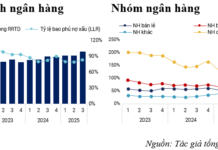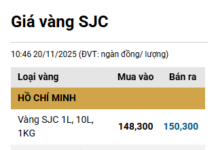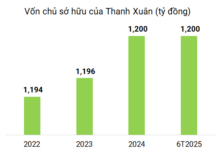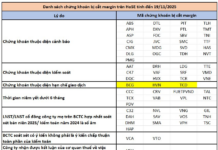
Northern province of Bac Giang recently held a conference on developing the local human resources. Photo: VGP.
Bac Giang Becoming Attractive Destination for Investors
According to Dr. Vo Xuan Hoai, Deputy Director of the National Center for Innovation (NIC), Bac Giang is emerging as a hot spot for domestic and international investors – a hub of production for many of the world’s leading electronics corporations. The province is also transforming to become a potential site for investment activities in electronics and semiconductors from foreign direct investment (FDI) sources.
With various advantages and potentials, promoting human resource development in the microelectronics industry and investing in and developing human resources in the semiconductor industry will not only benefit enterprises and Bac Giang province, but also actively contribute to the future sustainable development of Vietnam’s socio-economy.
Bac Giang currently has five major electronics technology clusters, namely Van Trung Industrial Zone, Dinh Tram Industrial Zone, Hoa Phu Industrial Zone, Quang Chau Industrial Zone, and Song Khe-Noi Hoang Industrial Zone. According to 2023 figures, Bac Giang attracted over US$3.2 billion in investment capital, of which FDI reached nearly US$3 billion, with 29 domestic projects and 89 newly-licensed FDI projects, mainly focused on manufacturing and processing of electronic components, garments, logistics, and others.
These impressive numbers indicate that Bac Giang is gradually transforming itself into a potential location for investment activities in the electronics and semiconductor industries, drawing FDI sources. For example, the province currently hosts Hana Micron Vina (South Korea), which is building the first semiconductor packaging and testing plant in the North, located in Van Trung Industrial Zone, with a total investment capital of nearly US$600 million. Foxconn Group has invested US$3.2 billion in Vietnam, establishing many subsidiaries in Bac Giang, such as Fukang, New Wing Interconnect Technology, Fuyu Precision Component, Fuhong Precision Component, and ShunSin Technology.
With the number of enterprises increasing, the demand for human resources for all stages in the semiconductor industry and its supporting industries is also changing rapidly. According to data from the Bac Giang Employment Service Center, in the first quarter of 2024, 25 enterprises registered to recruit about 30,000-35,000 workers, in which 70% of the recruitment demand focused on the electronics, electronics, and semiconductor industries.
Accordingly, Bac Giang needs to quickly implement various solutions to develop human resources for the semiconductor industry in order to timely meet the labor force demand of enterprises in the province.
According to the Department of Labor, Invalids, and Social Affairs of Bac Giang, in recent years, the province has been determined to attract investment for industrial development; directing to ensure the best conditions for attracting investors in the semiconductor industry to the province to invest. Therefore, the number of enterprises operating in Bac Giang is increasing rapidly, and many large corporations have invested and expanded production in the province, leading to a growing demand for labor.
In 2024, enterprises in the province need to recruit 112,000 people, including 68,400 women, accounting for 60.79% (the average demand for recruitment in the period 2025-2030 is 90,000 workers/year). There are currently three enterprises specializing in semiconductor manufacturing that are actively implementing investment projects in the locality.
These include Hana Micron Vina Co., Ltd., invested by South Korea, with a total registered investment capital of US$643 million for the project, aiming to produce and process integrated circuit boards used for mobile phones and other smart electronic products. Si Flex Vietnam Co., Ltd., invested by South Korea, with a total registered investment capital of US$299 million for the project, aiming to manufacture and assemble flexible printed circuit boards using surface-mount technology, produce heat sinks, stiffeners for printed circuit boards, and manufacture touch screens. Synergie Cad Vietnam Co., Ltd., with a total registered investment capital of US$21.2 million for the project, aiming to produce PCB boards for mounting semiconductors and semiconductor components, assembling components on PCB boards, repairing semiconductor components, and PCB boards.
Mr. Tran Dang Hoa, Chairman of FPT Semiconductor Joint Stock Company and Chairman of FPT IS Company (belonging to FPT Corporation), said that Bac Giang province is geographically well-positioned and has the potential to become a cradle of semiconductor labor force development thanks to its determination, readiness to embrace new development opportunities, and creation of conditions for working with both domestic and international partners.
Moreover, the province is also a land of talents, ranking among the top in the country in the field of education with more than 1,000 national-standard schools. In the first quarter of 2024, Bac Giang’s economy took the lead in the country. The province has three large enterprises investing in the semiconductor sector and five electronics industrial clusters. Bac Giang has a solid foundation for developing the semiconductor industry and becoming a cradle for training semiconductor labor force for enterprises and industrial parks.
Focusing on Training and Improving the Quality of Human Resources
According to Dr. Vo Xuan Hoai, to promote the potential, advantages, and growth of the semiconductor industry in the province, with the increasing number of enterprises and the rapid changes in the need for human resources in all stages of the semiconductor industry and supporting industries, Bac Giang needs to strengthen international cooperation, especially with countries and economies that have strengths in the semiconductor industry, such as the United States, Japan, South Korea, Taiwan (China), the Netherlands, Belgium, France, Germany, etc., to access FDI investment sources and international cooperation in training.
In addition, it is necessary to improve the capacity of universities, train lecturers, invest in infrastructure to promote research and development activities in the semiconductor industry. Allocate local budget funds to implement programs and projects for short-term hands-on training, retraining, advanced training and postgraduate training in semiconductor industry for cadres, lecturers, students at universities, research institutes, enterprises, and economic organizations.
The province also needs to proactively participate in and strengthen cooperation between the state, universities, research institutes, innovation centers, and enterprises to improve training effectiveness and create jobs for the labor force. Cooperate with major technical universities in the country – especially in Hanoi – in training activities, attracting good lecturers and experts to participate in the training and teaching process at the province’s training institutions.
The Department of Labor, Invalids, and Social Affairs of Bac Giang province said that in the coming time, to effectively carry out the key breakthrough tasks assigned by the Provincial Party Congress for the term 2020-2025 – which is to focus on training and improving the quality of the province’s labor force to meet the requirements of the new period, focusing on training skilled, high-quality technical workers – the Department of Labor, Invalids, and Social Affairs and other departments, sectors and localities will regularly review the training needs, employment and demand for specialized technical workers of enterprises, especially the training needs of the semiconductor and AI industries, including necessary skills and development trends in the industry.
Continuing to innovate, creating a strong shift in the quality of training and effectiveness of vocational education, especially focusing on building a team of vocational teachers and managers with capacity and qualifications that meet current requirements and tasks; developing the vocational education system towards openness, diversity, flexibility, interconnectivity, and modernity with various forms and levels of vocational training, especially high-quality training towards application, practice and ensuring the satisfaction of labor market demand for human resources trained both in quantity, quality, occupational structure, and training level.
Assoc. Prof. Dr. Truong Viet Anh, Head of the Science Division of Hanoi University of Science and Technology, shared that Bac Giang has a wealth of land resources and a young labor force so attracting factories and focusing on packaging and testing as it is currently doing is both common and appropriate. To develop the semiconductor industry, Bac Giang needs to focus on identifying goals and needs for training and human resource development in order to be ready to receive and attract investment, and serve the development of industrial parks.
In addition, the province needs to have a policy to attract qualified people from other localities to work in the province. Instruct universities and colleges in the province on the plan to improve training programs and majors in order to proactively provide on-the-spot training with a long-term perspective. The province also needs to prioritize Vietnamese enterprises with capability to master technology and localize, provide incentive and preferential mechanisms when investing in their operations in order to gradually





































